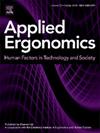Fairness in machine learning-based hand load estimation: A case study on load carriage tasks
IF 3.4
2区 工程技术
Q2 ENGINEERING, INDUSTRIAL
引用次数: 0
Abstract
Predicting external hand load from sensor data is essential for ergonomic exposure assessments, as obtaining this information typically requires direct observation or supplementary data. While machine learning can estimate hand load from posture or force data, we found systematic bias tied to biological sex, with predictive disparities worsening in imbalanced training datasets. To address this, we developed a fair predictive model using a Variational Autoencoder with feature disentanglement, which separates sex-agnostic from sex-specific motion features. This enables predictions based only on sex-agnostic patterns. Our proposed algorithm outperformed conventional machine learning models, including -Nearest Neighbors, Support Vector Machine, and Random Forest, achieving a mean absolute error of 3.42 and improving fairness metrics like statistical parity and positive and negative residual differences, even when trained on imbalanced sex datasets. These results underscore the importance of fairness-aware algorithms in avoiding health and safety disadvantages for specific worker groups in the workplace.
基于机器学习的手负荷估计公平性:以负荷搬运任务为例
根据传感器数据预测外部手负荷对于人体工程学暴露评估至关重要,因为获得这些信息通常需要直接观察或补充数据。虽然机器学习可以从姿势或力量数据中估计手部负荷,但我们发现与生物性别有关的系统性偏差,在不平衡的训练数据集中,预测差异会加剧。为了解决这个问题,我们使用带有特征解纠缠的变分自编码器开发了一个公平的预测模型,该模型将性别不可知的运动特征与性别特定的运动特征分开。这使得预测仅基于性别不可知论模式。我们提出的算法优于传统的机器学习模型,包括k近邻、支持向量机和随机森林,实现了3.42的平均绝对误差,并提高了公平指标,如统计奇偶性和正负残差,即使是在不平衡的性别数据集上训练。这些结果强调了公平意识算法在避免工作场所特定工人群体的健康和安全劣势方面的重要性。
本文章由计算机程序翻译,如有差异,请以英文原文为准。
求助全文
约1分钟内获得全文
求助全文
来源期刊

Applied Ergonomics
工程技术-工程:工业
CiteScore
7.50
自引率
9.40%
发文量
248
审稿时长
53 days
期刊介绍:
Applied Ergonomics is aimed at ergonomists and all those interested in applying ergonomics/human factors in the design, planning and management of technical and social systems at work or leisure. Readership is truly international with subscribers in over 50 countries. Professionals for whom Applied Ergonomics is of interest include: ergonomists, designers, industrial engineers, health and safety specialists, systems engineers, design engineers, organizational psychologists, occupational health specialists and human-computer interaction specialists.
 求助内容:
求助内容: 应助结果提醒方式:
应助结果提醒方式:


